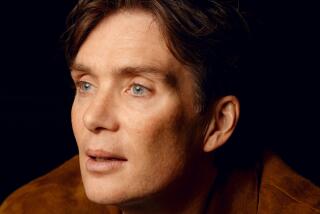‘Gleason’ documents more than one man’s life and decline; it reminds us to enjoy life

- Share via
Filmmaker Clay Tweel first encountered his latest subject, former NFL player Steve Gleason, via a tsunami of footage filmed after the New Orleans Saints player was diagnosed with amyotrophic lateral sclerosis, or Lou Gehrig’s disease, in 2011. At the time, Gleason and his wife, Michel, had just learned she was pregnant. Gleason soon began taping video journals to his unborn son, wanting to share as much as he could with his child while he could still speak.
When filming himself became too difficult, Gleason brought in two film students to take over, shooting fly-on-the-wall footage as Gleason physically disintegrated, eventually becoming paralyzed, using a wheelchair and breathing through a tube.
Overwhelmed by the 1,200-plus hours of footage they’d shot, the students began shopping it around to documentarians. “It took us 3 1/2 months just to watch the footage and organize it,” says Tweel, who took on the project in 2015. “So we were racing [to get it ready for the Sundance Film Festival in January 2016]. I take a lot of pride in my ability to craft a story using what I have, but that tested it to the full. You had to make a decision and go with it, and that became a benefit.” In the end, Tweel created a profoundly moving and gripping film.
Do you remember the first images you saw of Steve and his family?
At Sundance 2014 I saw this six-minute teaser trailer. It just rocked my world. I’m not someone who is easily emotional but at the end I was crying. I thought, ‘This movie is going to be so powerful.’ I just wanted to be a part of it. So I hopped on a plane down [to New Orleans] to meet Steve and Michel and the first thing Steve showed me – he controls everything in his house through a tablet using his eye movements – and he typed out, ‘Hey dude, watch this.’ And he brought up the faith healer scene (where his dad takes him to a faith healing meeting) on his TV screen. And my jaw dropped. I knew I had to be a part of telling this story.
You started off thinking the film would have a different core theme. Why?
With documentary, whatever you get on camera is it, this is real-life and unscripted. What you initially imagine is likely not what real life hands you. At first I thought the movie was going to be about a guy who was beset with a tragic set of circumstances and overcomes them despite all the odds and finds his purpose in life.
Which he does…
But it’s a side benefit. To me, the heart of the story, which I did not know when I started, was the inter-generational father story between him and his dad, and his own role as a father to his newborn son. And then Michel’s caretaker story; people connect to Michel and hone in on her story too and I’m pretty proud of that.
Did you fear that it could become too maudlin in parts?
That was one of our major fears. Our producer, Seth Gordon, very early on coined the term “compassion exhaustion.” It’s really dangerous to play it too saccharine and we were working against that emotive the entire time.
Since it was Steve who initially conceived the film, how involved was he in your editing and crafting stage?
The trust factor is an amazing part of this story. The vulnerability, candor and honesty of the footage is not something I took lightly. It was a big responsibility to not only present this man’s legacy to his own son but then to the world. I wanted to be very sure they trusted me to tell their story yet I wanted to have them involved so I was sure I wasn’t ever exploiting that trust. You lose perspective when you’re making a movie and you’re watching so many hours. So we showed Steve and Michel a couple of cuts of the movie as it got more polished and had a dialogue with them to make sure that we weren’t crossing that line.
What did you learn from the Gleason experience that you didn’t know before?
There are so many it’s hard to pinpoint but the core of it and what I wanted the audience to take away is the same thing I took away; a perspective on my own life: As much as you can, enjoy the beautiful mess that is life. That’s what I felt when I was watching the footage and spending time with the family so I wanted that to come across. The tragedy and the comedy, the love and the loss is all wrapped in one.
See the most read stories this hour »
More to Read
Sign up for The Envelope
Get exclusive awards season news, in-depth interviews and columnist Glenn Whipp’s must-read analysis straight to your inbox.
You may occasionally receive promotional content from the Los Angeles Times.







